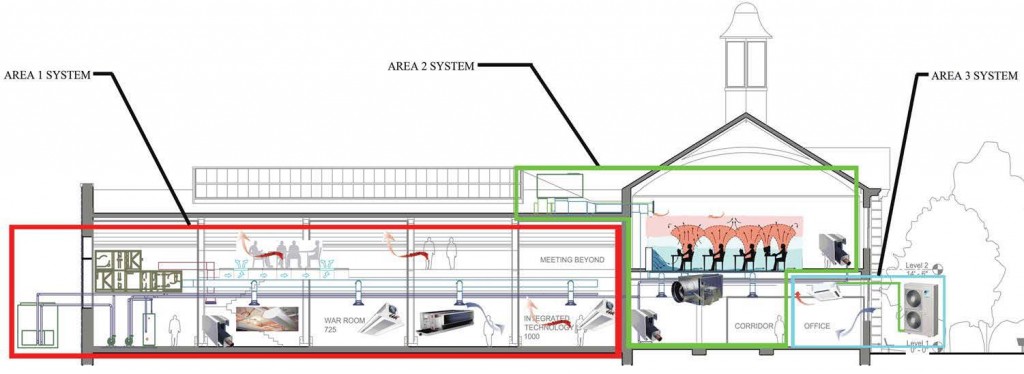CBEI researchers have moved into their new home in November of 2014 at The Navy Yard in Philadelphia. The new headquarters building was designed as a living laboratory for building science researchers to test the real-world application of a number of energy conservation measures. The building, a deep retrofit of a 1940s Navy recreation center, takes advantage of a tight building envelope and incorporates three distinct building areas that anticipate distinct occupancy patterns, each with a distinct fit-for-purpose HVAC system. Each area showcases a unique off-the-shelf technology solution and this configuration gives researchers the chance to compare the systems’ performance with the design projections.
| Area 1 | Area 2 | Area 3 |
| Dedicated outdoor air (DOA) unit with exhaust air energy recovery (enthalpy wheels), desiccant dehumidification and hot waterregeneration (chiller heat recovery and supplemental condensing boiler) | Three heat recovery RTUs | Variable refrigerant volume multi-split system for first floor offices |
| Passive and active chilled beams | Two zones with displacement ventilation | No supplemental heating |
| Heat recovery chiller providing regenerative heating and reheat duringcooling season | One zone under floor air delivery with displacement diffusers | Natural ventilation |
| One zone wall based displacement ventilation | ||
| One zone VAV |
Workers are still adding some final touches to the headquarters building and the mechanical systems are still being commissioned. CBEI’s Demonstration Program Manager, Mark Stutman, took advantage of this period of fine-tuning to hold a post-construction meeting with key project stakeholders. This meeting was of value, as it allowed the design and construction stakeholders to communicate the design intent of the building, compromises made during construction, and system and operational issues that will be of value to the building managers and occupants in providing a comfortable building. It was also an opportunity to bring the new contract building management firm up to speed on the complexities of the system and challenges that remain through the commissioning phase. Along with CBEI researchers and the building managers (Athenian-Razak), the meeting was attended by the project manager (Hill International), mechanical design consultants (Bruice Brooks and Associates), commissioning agents (Aramark Facilities & Services), and the HVAC Prime contractor and Building Automation System installer (Devine Brothers/Dynamic Controls).
The greatest challenge discussed at the meeting is that the north side of the building’s high bay area has not been fitted out, because CBEI’s staffing needs were reduced between the design and construction phases, and Penn State elected to delay fit-out until the use of that space is determined. This northern high bay section is currently being operated as a shell space, which is impacting equipment that was designed to operate with this space conditioned and occupied. This same space will also create challenges in cooling the building in the warmer season. The CBEI Design to Occupancy meeting provided the opportunity for all stakeholders to review these challenges and begin to work through viable solution options.

